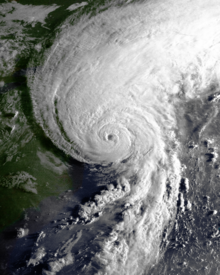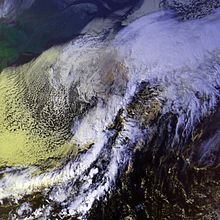
The 2005 Atlantic hurricane season was an event in the annual tropical cyclone season in the north Atlantic Ocean. It was the second most active Atlantic hurricane season in recorded history, and the most extreme in the satellite era. Officially, the season began on June 1, 2005 and ended on November 30, 2005. These dates, adopted by convention, historically delimit the period in each year when most tropical systems form. The season's first storm, Tropical Storm Arlene, developed on June 8. The final storm, Tropical Storm Zeta, formed in late December and persisted until January 6, 2006. Zeta is only the second December Atlantic storm in recorded history to survive into January, joining Hurricane Alice in 1955.

The 2008 Atlantic hurricane season was an event in the annual tropical cyclone season in the north Atlantic Ocean. An above-average Atlantic hurricane season season, it was the first on record to have a major hurricane in every month from July to November.

The 1995 Atlantic hurricane season was an event in the annual tropical cyclone season in the north Atlantic Ocean. This Atlantic hurricane season saw a near-record number of named tropical storms. This extremely active season followed four consecutive years in which there was below normal activity. The season officially began on June 1, 1995 and ended on November 30, 1995. These dates, adopted by convention, historically describe the period in each year when most tropical systems form. The season's first system, Hurricane Allison, developed on June 3; its last, Hurricane Tanya, became extratropical on November 2.

The 2001 Atlantic hurricane season was an above-average Atlantic hurricane season in which fifteen named storms formed. The season officially began on June 1 and ended on November 30, dates that conventionally delimit the period of each year when most tropical cyclones form in the Atlantic basin. The season's first tropical cyclone, Tropical Storm Allison, formed on June 5 while the season's final system, Hurricane Olga, dissipated on December 6.

The 1996 Atlantic hurricane season had 13 named storms, of which 9 became hurricanes and 6 became major hurricanes. These major hurricanes were Bertha, Edouard, Fran, Hortense, Isidore, and Lili. This timeline documents all the storm formations, strengthening, weakening, landfalls, extratropical transitions, as well as dissipation. The timeline also includes information that was not operationally released, meaning that information from post-storm reviews by the National Hurricane Center, such as information on a storm that was not operationally warned on, has been included. The season officially began on June 1, 1996, and ended on November 30 that same year.

The 1993 Atlantic hurricane season consisted of the events that occurred in the annual cycle of tropical cyclone formation over the Atlantic Ocean north of the Equator. The official bounds of each Atlantic hurricane season are dates that conventionally delineate the period each year during which tropical cyclones tend to form in the basin according to the National Hurricane Center, beginning on June 1 and ending on November 30. However, tropical cyclogenesis is possible at any time of the year, as evidenced by the development of Tropical Depression One on May 31, one day before the official start of the season. By contrast, the dissipation of Tropical Depression Ten on September 30 effectively concluded the season two months before it officially ended. September 21 was the final date on which a system of at least tropical storm strength was active; this was described in a 1995 retrospective from Monthly Weather Review as the earliest such occurrence since 1930. Seasonal activity was below average – of the season's 10 tropical depressions, eight strengthened further to become named tropical storms and four became hurricanes: compared to contemporary long-term averages of 10 tropical storms and six hurricanes; and modern averages of 14 tropical storms and seven hurricanes. Hurricane Emily was the only Atlantic major hurricane in 1993; this is slightly below the contemporary average of two major hurricanes per season, while modern seasons produce three on average.

The 2009 Atlantic hurricane season was an event in the annual tropical cyclone season in the north Atlantic Ocean. It was below-average Atlantic hurricane season with nine named storms, the fewest since the 1997 season. The season officially began on June 1, 2009, and ended on November 30, 2009, dates that conventionally delimit the period of each year when most tropical cyclones develop in the Atlantic basin. The first storm to form was Tropical Depression One on May 28, 2009, while the last storm, Hurricane Ida, dissipated on November 10.
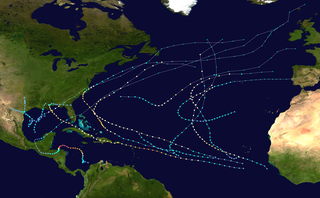
The 1998 Atlantic hurricane season was an event in the annual tropical cyclone season in the north Atlantic Ocean. This Atlantic hurricane season saw an above-average number of named tropical storms, and included a single-day record for number of hurricanes simultaneously in progress, with four active on September 25: Georges, Ivan, Jeanne and Karl. The season officially began on June 1, 1998 and ended on November 30, 1998. These dates, adopted by convention, historically describe the period in each year when most tropical systems form. Even so, this season's first storm, Tropical Storm Alex, did not form until July 27, while its last, Hurricane Nicole, dissipated on December 1.

The 2002 Atlantic hurricane season was an average Atlantic hurricane season in which twelve named storms formed. Although Tropical Storm Arthur formed on July 14, the season officially began on June 1 and ended on November 30, dates that conventionally delimit the period of each year when most tropical cyclones develop in the Atlantic basin. The season's final storm, Tropical Depression Fourteen, dissipated on October 16.

The 1999 Atlantic hurricane season was an event in the annual tropical cyclone season in the north Atlantic Ocean. This Atlantic hurricane season saw a near-average number of named tropical storms, though five of them became dangerous hurricanes of Category 4 intensity on the 5-level Saffir–Simpson scale, the most in a single season since 1886. The season officially began on June 1, 1999 and ended on November 30, 1999. These dates, adopted by convention, historically describe the period in each year when most tropical systems form. This season's first storm, Tropical Storm Arlene, formed on June 11, while the last, Hurricane Lenny, dissipated on November 23.

The 1985 Atlantic hurricane season was an event in the annual Atlantic hurricane season in the north Atlantic Ocean. It featured average activity overall, with thirteen tropical cyclones, eleven tropical storms, seven hurricanes, and three major hurricanes. The season officially began on June 1, 1985 and ended November 30, 1985. These dates, adopted by convention, historically describe the period in each year when most systems form. The season's first storm, Tropical Storm Ana, developed on July 15; the season's final storm, Tropical Depression Thirteen, dissipated on December 9.
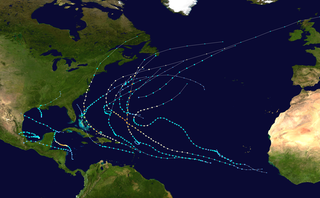
The 2011 Atlantic hurricane season was an event in the annual hurricane season in the north Atlantic Ocean. It was well above average, with 19 tropical storms forming. Even so, it was the first season on record in which the first eight storms failed to attain hurricane strength. The season officially began on June 1, 2011, and ended on November 30, 2011, dates that conventionally delimit the period of each year when most tropical cyclones develop in the Atlantic basin. The season's first storm, Tropical Storm Arlene did not form until June 28. The final storm to develop, Tropical Storm Sean, dissipated on November 11.

The 2012 Atlantic hurricane season was an event in the annual hurricane season in the north Atlantic Ocean. For the third year in a row there were 19 named storms. The season officially began on June 1, 2012, and ended on November 30, 2012, dates that conventionally delimit the period of each year when most tropical cyclones develop in the Atlantic basin. Surprisingly, two preseason storms formed: Alberto on May 19, and Beryl on May 26. This was the first such occurrence since the 1951 season. The final storm to dissipate was Sandy, on October 29. Altogether, ten storms became hurricanes, of which two intensified into major hurricanes.

The 2015 Atlantic hurricane season was an event in the annual hurricane season in the north Atlantic ocean.(there were 15 different recorded hurricanes this year). It was the third consecutive year to feature below-average tropical cyclone activity, with eleven named storms. The season officially began on June 1, 2015 and ended on November 30, 2015. These dates, adopted by convention, historically describe the period in each year when most tropical systems form. However, systems can and do form outside these dates, as did the season's first storm, Tropical Storm Ana, which developed on May 8; the season's final storm, Hurricane Kate, lost its tropical characteristics on November 11.

The 2016 Atlantic hurricane season was an event in the annual tropical cyclone season in the north Atlantic Ocean. It was the costliest, as well as the first above-average, Atlantic hurricane season since the 2012 season. It featured the highest number of deaths since the 2008 season and also yielded the highest number of named storm landfalls on the United States since that year. The season officially began on June 1 and concluded on November 30, dates which conventionally delimit the period during each year when a majority of tropical cyclones form in the Atlantic Ocean. The season's first cyclone, Alex, developed on January 12, while the final storm of the season, Otto, closed-out the season by exiting into the Eastern Pacific on November 25, becoming the first Atlantic–Pacific crossover hurricane since Hurricane Cesar–Douglas in 1996.

The 2017 Atlantic hurricane season was an event in the annual tropical cyclone season in the north Atlantic Ocean. This Atlantic hurricane season saw above-normal activity; it was the seventh most active season on record and the most active since 2005. The season officially began on June 1, 2017 and ended on November 30, 2017. These dates, adopted by convention, historically describe the period in each year when most tropical systems form. However, storm formation is possible at any time of the year, as demonstrated in 2017 by the formation of the season's first named storm, Tropical Storm Arlene, on April 19. The final storm of the season, Tropical Storm Rina degenerated to a remnant area of low pressure on November 9.
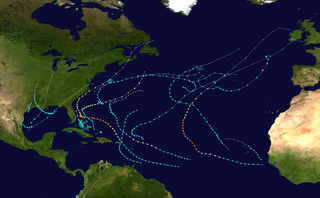
The 2019 Atlantic hurricane season was an event in the annual tropical cyclone season in the north Atlantic Ocean. It was the fourth consecutive above-normal Atlantic hurricane season. The season officially began on June 1, 2019 and ended on November 30, 2019. These dates, adopted by convention, historically describe the period in each year when most tropical systems form. However, storm formation is possible at any time of the year, as demonstrated in 2019 by the formation of the season's first named storm, Subtropical Storm Andrea, on May 20. The final storm of the season, Tropical Storm Sebastien, transitioned to an extratropical cyclone on November 25.

The 2020 Atlantic hurricane season was the most active Atlantic hurricane season on record in terms of number of named storms. Additionally, it was as an above-average season for tropical cyclones for the fifth consecutive year. The season officially began on June 1, 2020, and ended on November 30, 2020. These dates, adopted by convention, historically delimit the period each year when most Atlantic tropical systems form. However, storm formation is possible at any time of the year, as was the case this season, when its first two named storms, Tropical Storm Arthur and Tropical Storm Bertha, formed on May 16 and May 27, respectively. The final storm, Hurricane Iota, dissipated on November 18.

The 2021 Atlantic hurricane season was the third most active Atlantic hurricane season on record with 21 named storms, and the sixth consecutive year in which there was above-average tropical cyclone activity The season officially began on June 1, 2021, and ended on November 30, 2021. These dates, adopted by convention, historically describe the period in each year when most Northern Atlantic tropical cyclones form. However, tropical cyclone formation is possible at any time of the year, as was the case this season, when Tropical Storm Ana formed on May 22. The season's final system, Tropical Storm Wanda, dissipated on November 7. Of the season's 21 named storms, seven became hurricanes, and four further intensified into major hurricanes. The season's most devastating storm was Hurricane Ida. It made landfall in Louisiana with maximum sustained winds of 150 mph (240 km/h), destroying coastal communities in its path; parts of the New Orleans metropolitan area were left without power for several weeks. The storm caused an estimated $75 billion in damages in the U.S. and it was responsible for 87 deaths. Over half of those deaths occurred in New York and New Jersey, as the hurricane's remnants brought rains that triggered widespread flooding throughout that region. Additionally, heavy rains caused widespread flooding and landslides across Venezuela as Ida's precursor tropical wave passed though the southeastern Caribbean Sea, resulting in at least 20 deaths. In April 2022, the name Ida was retired from reuse in the North Atlantic by the World Meteorological Organization due to the extraordinary amount of damage and number of fatalities it caused.
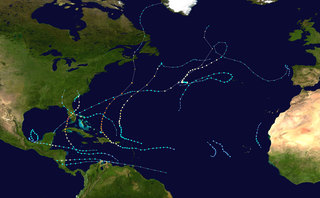
The 2022 Atlantic hurricane season saw an average number of named storms and hurricanes, and below average number major hurricanes. There were fourteen named storms during the season; eight of them strengthened into a hurricane, and two of those reached major hurricane intensity. The season officially began on June 1, and ended on November 30. These dates, adopted by convention, historically describe the period in each year when most subtropical or tropical cyclogenesis occurs in the Atlantic Ocean. No subtropical or tropical development occurred in the Atlantic prior to the start of the season, making this the first since 2014 not to have a pre-season named storm. The season's first storm, Tropical Storm Alex, formed on June 5, and the last, Hurricane Nicole, dissipated on November 11.



